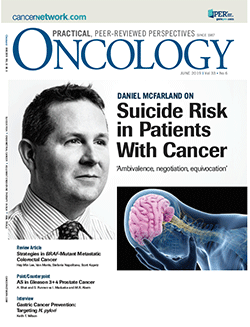Point: Should Active Surveillance Be Used for Gleason 3+4 Prostate Cancer?
In this Point/Counterpoint, Drs. Bhat and Punnen argue that active surveillance can be beneficial for patients with intermediate-risk prostate cancer.
Oncology (Williston Park). 33(6):235-6.

Abhishek Bhat, MD

Sanoj Punnen, MD, MAS

While the use of active surveillance among men with low-risk prostate cancer has increased, its role in men with intermediate-risk disease remains debatable. Current American Society of Clinical Oncology (ASCO)/Cancer Care Ontario (CCO) guidelines recommend treatment for most men with intermediate-risk disease, but state that men with low-volume Gleason 3+4 prostate cancer may be considered for active surveillance.[1] The recent National Comprehensive Cancer Network (NCCN) guidelines list active surveillance as an initial therapy option for men with favorable intermediate-risk disease, which they define as clinical stage T2b-T2c, Gleason score 3+4, or prostate-specific antigen (PSA) levels at 10–20 ng/mL, as well as less than 50% of positive biopsy cores.[2] While it remains an option in current guidelines and has been increasing in contemporary clinical practice,[3] there remains significant controversy over the safety of active surveillance in intermediate-risk prostate cancer.
The best evidence supporting active surveillance comes from the Prostate Intervention vs Observation Trial (PIVOT), which randomized 731 men with localized prostate cancer to observation vs radical prostatectomy from 1994 to 2002.[4] In a subgroup analysis of 249 men with intermediate-risk prostate cancer, the study found no difference in prostate cancer–specific mortality between the two groups. The authors reported an updated series with a decade more follow-up, again showing no difference in prostate cancer–specific mortality between intermediate-risk patients choosing active surveillance vs radical treatment.[5]
Similarly, the ProtecT trial randomized 1,643 men with localized prostate cancer to undergo treatment with active surveillance, radiotherapy, or surgery from 1999 to 2009.[6] With a median follow-up of 10 years, the study reported a low incidence of prostate cancer mortality, with no difference between the treatment groups. It is worth noting that nearly 80% of the patients on this study were considered low risk, and the follow-up for this endpoint could be considered short. However, both trials provide level 1 evidence in support of active surveillance for localized prostate cancer.
Further evidence supporting active surveillance for intermediate-risk patients comes from various prospective institutional cohorts. In 2011, the University of California, San Francisco, reported their data comparing intermediate-and low-risk patients who underwent active surveillance. Within the first 4 years of follow-up, the study found no difference in the rate of men experiencing progression of cancer or a difference in the proportion of men undergoing treatment between the two groups.[7] In contrast to this, a previous report from the University of Toronto showed an increased risk of late metastasis in men with intermediate-risk prostate cancer who chose active surveillance.[8] This relationship was primarily driven by men with Gleason 7 prostate cancer. However, these men were selected and monitored by clinical and pathologic criteria only and perhaps underwent serial biopsy too infrequently for their level of risk.
While it remains unclear whether active surveillance in intermediate-risk patients is beneficial, it is likely that some men with intermediate-risk prostate cancer will need treatment, while others may be able to safely avoid it. The evidence suggests that those who are defined as intermediate risk based on their PSA levels, rather than stage or grade, are likely to harbor the same risk as men with low-risk prostate cancer.[9] However, the question of whether active surveillance is beneficial in men with Gleason 7 prostate cancer is more difficult. What is clear is that selection is critical. While some studies based on radical prostatectomy series have suggested that typical clinical and pathologic criteria are incapable of selecting a favorable group of intermediate-risk patients who would not be at risk for an adverse outcome when selecting active surveillance,[10] it is difficult to know whether data based on surgical patients would generalize appropriately to true active surveillance patients who are not choosing immediate radical therapy.
In addition, contemporary methods of risk assessment and novel prognostic markers show much progress for improving risk stratification and decision making regarding treatment vs observation.[11] For instance, the most powerful prognostic tool we have in prostate cancer is the histopathologic Gleason score. However, most prostate cancer reports stratify Gleason 7 into two groups (3+4/4+3), losing valuable information and grossly underestimating the degree of heterogeneity in risk that exists within the Gleason 3+4 group. Recent studies have supported the usage of quantitative Gleason scoring in men with Gleason 3+4 prostate cancer on biopsy to allow better quantification of the pattern 4 cancer that poses the increased risk, thereby facilitating better risk assessment for decision making.[12,13] Why not take advantage of the most important information we have, especially when we can get it for free? Additionally, there has been a significant emergence of evidence for the role of MRI and tissue genomics in active surveillance.[14,15] Perhaps with these tools we will be able to better discriminate between men with Gleason 7 prostate cancer who can and cannot safely monitor their prostate cancer.
At the University of Miami, we have nearly completed enrollment of 200 men who will monitor their cancer with annual MRI, prostate biopsy, and tissue genomic studies for a funded program by the National Institutes of Health/National Cancer Institute. The study allows men with up to four cores of prostate cancer, of which two can be Gleason 3+4. While most men are still in the follow-up stages of the protocol, we believe this study will provide invaluable information regarding the utility of these novel markers in men with low- and intermediate-risk cancer undergoing active surveillance. Future studies, like this one, incorporating novel risk stratification tools in the selection and monitoring of intermediate-risk patients choosing active surveillance will allow further discovery into the appropriateness of observation in these men, as well as the selection criteria that are unlikely to compromise their outcomes.
Financial Disclosure:The authors have no significant financial interest in or other relationship with the manufacturer of any product or provider of any service mentioned in this article.
References:
1. Chen RC, Rumble RB, Loblaw DA, et al. Active surveillance for the management of localized prostate cancer (Cancer Care Ontario Guideline): American Society of Clinical Oncology Clinical Practice Guideline endorsement. J Clin Oncol. 2016;34:2182-90.
2. Mohler JL, Lee RJ, Antonarakis ES, et al. NCCN Clinical Practice Guidelines in Oncology: Prostate Cancer. Version 3.2018. https://www.nccn.org/patients/guidelines/prostate/. Accessed April 8, 2019.
3. Cooperberg MR, Carroll PR. Trends in management for patients with localized prostate cancer, 1990-2013. JAMA. 2015;314:80-2.
4. Wilt TJ, Brawer MK, Jones KM, et al. Radical prostatectomy versus observation for localized prostate cancer. N Engl J Med. 2012;367:203-13.
5. Wilt TJ, Jones KM, Barry MJ, et al. Follow-up of prostatectomy versus observation for early prostate cancer. N Engl J Med. 2017;377:132-42.
6. Hamdy FC, Donovan JL, Lane JA, et al. 10-year outcomes after monitoring, surgery, or radiotherapy for localized prostate cancer. N Engl J Med. 2016;375:1415-24.
7. Cooperberg MR, Cowan JE, Hilton JF, et al. Outcomes of active surveillance for men with intermediate-risk prostate cancer. J Clin Oncol. 2011;29:228-34.
8. Yamamoto T, Musunuru B, Vesprini D, et al. Metastatic prostate cancer in men initially treated with active surveillance. J Urol. 2016;195:1409-14.
9. Loeb S, Folkvaljon Y, Bratt O, et al. Defining intermediate-risk prostate cancer suitable for active surveillance. J Urol. 2019;201:292-9.
10. Patel HD, Tosoian JJ, Carter HB, Epstein JI. Adverse pathologic findings for men electing immediate radical prostatectomy: defining a favorable intermediate-risk group. JAMA Oncol. 2018;4:89-92.
11. Komisarenko M, Martin LJ, Finelli A. Active surveillance review: contemporary selection criteria, follow-up, compliance and outcomes. Transl Androl Urol. 2018;7:243-55.
12. Dean LW, Assel M, Sjoberg DD, et al. Clinical usefulness of total length of Gleason pattern 4 on biopsy in men with grade group 2 prostate cancer. J Urol. 2019;201:77-82.
13. Reese AC, Cowan JE, Brajtbord JS, et al. The quantitative Gleason score improves prostate cancer risk assessment. Cancer. 2012;118:6046-54.
14. Johnson LM, Choyke PL, Figg WD, Turkbey B. The role of MRI in prostate cancer active surveillance. BioMed Res Int. 2014;2014:203906.
15. Donovan MJ, Cordon-Cardo C. Genomic analysis in active surveillance: predicting high-risk disease using tissue biomarkers. Curr Opin Urol. 2014;24:303-10.
